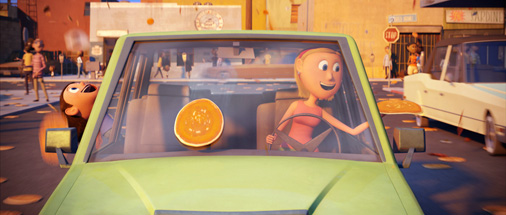|
|
Book vs. Movie: Cloudy With a Chance of MeatballsBy Russ BickerstaffSeptember 22, 2009
The Book At 32 pages, the book is an exceedingly quick read. I say this having not had the benefit of having been introduced to the book at a time when I would've fit into its target demographic. The book has scores of adult fans who have fond memories of having the book read to them as children. The fact that the book has had that kind of longevity speaks to its overwhelming popularity. It's hard to quantify the book's popularity, but a good indicator of this is the fact that in its first ten years, the book had already gone through some 20 printings. This is a very, very popular book. The story is told from the perspective of two children (one boy and one girl) who are sitting down to a breakfast of pancakes being prepared by their grandfather. A dog chases a cat, disturbing the grandfather, who accidentally tosses a pancake on the head of the boy. This prompts the grandfather to tell them a bedtime story later on that evening about a mythical town of Chewandswallow - a place blessed with edible weather. The book proceeds to outline in remarkable and remarkably clever detail the plight of a town where weather came three times a day in the form of food that would drop from the sky. People would check the weather report like a menu. There were restaurants without ceilings. The sun would set as a giant Jell-O mold. This is precisely the type of thing that has no difficulty capturing the imagination of its target audience, but the story doesn't end there. Of course, it just wouldn't be a story without conflict and the book begins to detail problems with the edible weather. A torrential storm of spaghetti brings traffic to a standstill. The weather would come up with inedible combinations like brussel sprouts with peanut butter and mayo. There were 15-inch drifts of cream cheese and jelly sandwiches. There were salt and pepper tornadoes. It got to be too much. So the people of Chewandswallow left town to gradually become acquainted with the idea of buying food at the supermarket. The brother and sister fall asleep and awaken the following morning to a heavy snowfall. They're out sledding the next day and the sun over a snow hill looks distinctly like a pat of butter on a giant mound of mashed potatoes.
[ View other columns by Russ Bickerstaff ]
[ View other Book vs. Movie columns ]
[ Email this column ]
|

|
|
|

|
Friday, November 1, 2024
© 2024 Box Office Prophets, a division of One Of Us, Inc.


